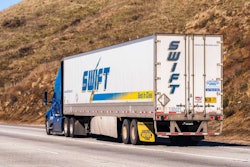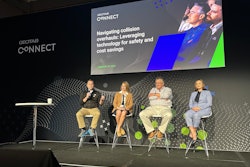It’s no surprise that distracted driving is the cause of many collisions and near collisions. But it has become such a problem that professional drivers – who have historically been known to shun even the idea of using dash cameras – are now beginning to support the technology with the use of artificial intelligence to improve driver safety.
It was estimated that 80% of collisions and 65% of near collisions involve some form of driver distraction, according to a National Highway Traffic Safety Administration study conducted with the Virginia Tech Transportation Institute. That is backed by a Samsara report in which 79% of 1,500 commercial drivers surveyed said they experienced a “close call” or near-miss because of distracted driving with 93% experiencing the negative effects of distracted driving: vehicle damage (37%), personal injury (32%), fines (30%) and license suspension or revocation (30%). According to a recent Teletrac Navman survey, 49% of respondents said distracted driving had a direct financial cost on their business.
In Samsara’s State of Connected Operations Report: Behind the Wheel: Distracted Driving in Physical Operations, released Tuesday, 76% of drivers identified the use of personal mobile devices to read and send messages and check social media as the top distraction. In addition, 74% use their phones or other technology while driving for work-related tasks.
The report also concluded that 54% of drivers identified AI-powered detection and alerts as the top technology drivers want to combat distraction.
"Our experience with customers consistently demonstrates the transformative impact of AI dash cams and comprehensive safety programs," said Evan Welbourne, head of AI and data at Samsara. "By combining advanced technology with positive recognition and proactive coaching, organizations can significantly reduce distracted driving incidents and cultivate a safer, more engaged driver workforce for the long term. These tools provide invaluable insights, enabling targeted training and fostering a culture of safety that benefits both drivers and the broader community."
Others agree that AI is the future of safety, according to fleets that participated in Teletrac Navman’s AI & Driver Safety survey. Of the fleets that participated in the company’s supplement to its 2025 Distracted Driving & Driver Safety Report, 83% said AI is the future of safety.
[RELATED: Applications of AI in the trucking industry]
According to the survey, 26% are testing or piloting AI safety solutions, and 18% are exploring options.
Thirty-two percent said they are using AI to monitor driver behavior in real time to reduce distracted driving incidents (16%); predict and prevent potential accidents (17%); improve vehicle maintenance (14%); and enhance training/coaching through data insights (13%).
“The use of AI by fleets is expanding from primarily fleet planning to fleet operations,” said Teletrac Navman CEO Alain Samaha. “There are clear safety advantages in harnessing AI with vehicle and dashcam data, including preventing accidents by reducing distracted driving, and our customers are turning to Teletrac Navman and TN360 as a partner in achieving these results.”
Teletrac Navman currently uses AI to capture safety events, including severe speeding, tailgating, sign and signal violations, drowsiness, seatbelt usage and distraction.
Events detected by the AI camera are fed into a driver coaching model that leverages machine learning to recommend driver coaching activities to drive corrective actions. The AI cameras can also biometrically determine who was driving the vehicle, allowing fleets to minimize unassigned drive time and maximize coaching impact and corrective action workflows.
The Samsara report confirmed the value of visual feedback as 93% of drivers surveyed said that reviewing dash camera footage of their driving had increased their awareness of distracted behaviors. AI-driven digital platforms have emerged as the preferred training method, favored by 64% of drivers, according to the Samsara report.
But humans are still integral.
[RELATED: Synergy in AI and the human element perfect fleet safety]
In Teletrac Navman’s survey, 47% said human interaction is crucial for effective decision making, and 37% said humans provide accountability and ethical oversight.
“Camera and telematic data, in combination with AI, have the potential to be a very powerful tool for fleets who need to cut their exposure to risk,” Samaha said. “However, people are integral to making that happen, especially in situations where there may be concerns from drivers and unions. Effective communication is key.”
Improved communication is one of the top things respondents to Samsara’s survey said could help reduce work-related mobile use to mitigate distraction. Drivers reported the top three ways employers could help them reduce work-related mobile use on the road include improved communication systems to limit work-related calls and messages (44%), better in-cab routing and navigation (43%) and implementing policies that prioritize safety over speed (42%).
Additional survey insights:
• Samsara’s survey also found that 90% of drivers are more likely to stay with companies that proactively address distracted driving through preventative strategies.
• In Samsara’s survey, 82% of drivers indicate that positive reinforcement, such as recognition and incentives, is a more effective deterrent to distracted driving than punitive measures.
• Ninety-seven percent of drivers receive targeted coaching and training in the U.S. and Canada, and 95% of drivers reported improved driving habits following such programs, according to Samsara.
• Drivers in the Samsara survey also emphasized the effectiveness of regulatory changes in improving safe driving. For instance, 49% of drivers would support policies requiring in-vehicle safety features such as in-cab alerts, demonstrating a strong demand for technological interventions that support safe driving practices.
• Implementing AI comes with concerns and challenges. In Teletrac Navman’s survey, 23% said they were concerned about data privacy despite 66% being aware of the safety benefits of AI.













